|
***The Greek Goddesses: F-N***
Achelois to Eutychia | Odyne to Volupta
| A quick note: We transliterate the "phi" of ancient greek to "ph," not "f" - so the only ones you'll find with "f" are translations. |
- The Fates
- The Fates, also called the Moerae or the Parcae, determined when life begins, when it ends, and what happens in between. They were made up of three women:
- Clotho, who appeared as a maiden and spun the thread of life. Her name meant The Spinner
- Lachesis, who appeared as a matron and measured the thread of life. She was the Caster of lots
- Atropos, who cut the thread of life, and appeared as a crone. Her name meant, Unbending Though the smallest of the three, she is the most terrible.
They were the daughters of Erebus (Darkness) and Nyx (or of Zeus and Themis). Some say that Zeus could intervene in their decisions and that they could be manipulated, but in most myths they were eternal and more powerful than any of the Gods. Another story says they are the parthenogenic daughters of Ananke. In Delphi, they only worshipped Clotho and Atropos.
| 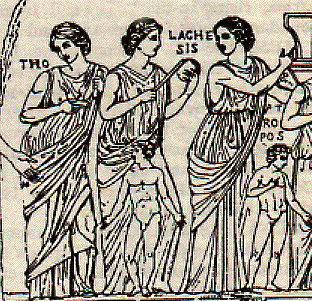 |
FuriesSee the Erinnyes.

*Gaia*
Gaia is Mother Earth. She has her own page, of course. She is from whom everything comes, but she is not quite a divinity, because she is Earth. She bore the Titans as well as monsters like the hundred armed men, and some of the Cyclopes - others were sons of Poseidon. She was the daughter of Chaos, and the mother of all creatures (according to some). She was the first and the last, and wanted all of her children, no matter what. She was primarily spoken of as a Mother of other Gods, rather than having her own myths. Read more about Gaia.
GanymedaShe was the original cupbearer to the Gods in Greek Mythology. But as time went on her person was split into two: Ganymede, who kept her duties as cupbearer; and Hebe (see below).
GerasShe was the personification of Old Age, and one of the icky things that flew out of the jar at Pandora.
The Graiai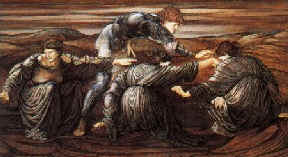 The Graiai, or the the three Gray Sisters, were beautiful. They were described as "fair-faced and swan-like" but they's had gray hair from the day they were born and they shared one eye and one tooth, but they lost even that when Perseus stole their eye and later threw it in a lake. Despite being so easily taken advantage of, they were very wise. Their names were: The Graiai, or the the three Gray Sisters, were beautiful. They were described as "fair-faced and swan-like" but they's had gray hair from the day they were born and they shared one eye and one tooth, but they lost even that when Perseus stole their eye and later threw it in a lake. Despite being so easily taken advantage of, they were very wise. Their names were:- Deino or Dread (or Terrible)
- Enyo or Horror (or War-like)
- Pemphredo or Alarm (or Wasp)
They were probably goddesses worshipped by the swan cults (swans were not just a symbol of beauty, but also of cunning and other darker meanings).
The GracesI'd hope that you'd know this by now, but I guess you just aren't very observant. The Graces are also known as the Charites, and therefore are on the Goddesses A-E page.
HaliaHalia was the personification of the saltiness of the Sea.
HalsodyneShe was a sea goddess - but I don't know any more than that yet.
HarmoniaEveryone knows Harmonia, but very few know much about her. She was the daughter of Aphrodite and Ares (NOT Zeus and Electra, no matter what those sources say), a love child if you will. Perhaps it was for that reason that she was the Goddess of Harmony and Concord, big surprise with a name like Harmonia, huh? Anyway, she was married to Cadmus (you definitely should know Cadmus, look for the story pages coming soon), and recieved a VERY infamous necklace as a gift (it caused the downfall of many a happy home and hero) from Aphrodite. She was the mother of Semele and Ino. Her daughters had tragic lives as well, you can read about them in the Humans section.
HebeHebe was the Goddess of Youth as well as the Cupbearer to the Gods, her mother was Hera and her father, Zeus. According to one story, she resigned as cupbearer to the gods upon her marriage to the hero Heracles, who had just been deified. That statue on the right is Hebe, but there is another bust of her at the bottom of the page. She was originally called Ganymeda (see above).
|  |
Hecate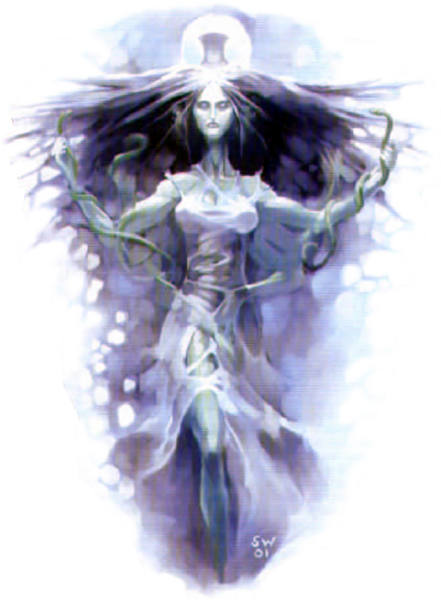 Hecate is the Third and final one of the Triple Goddess. She is the Goddess of the New Moon. She was also the Goddess of the Crossroads and the Witch Goddess. She was Thracian in origin, and she dwelt in the Underworld with Hades and Persephone. She was the daughter of the Titans Perses and Asteria(daughter of Phoebe and Coeus), both were symbols of shining light. Later she was said to be of Zeus and Hera. She was the Dark Link between the Underworld and Earth. Her children were Medea, Apsyrtus (a ghost), and one other I don't know. Hecate is the Third and final one of the Triple Goddess. She is the Goddess of the New Moon. She was also the Goddess of the Crossroads and the Witch Goddess. She was Thracian in origin, and she dwelt in the Underworld with Hades and Persephone. She was the daughter of the Titans Perses and Asteria(daughter of Phoebe and Coeus), both were symbols of shining light. Later she was said to be of Zeus and Hera. She was the Dark Link between the Underworld and Earth. Her children were Medea, Apsyrtus (a ghost), and one other I don't know.
HegemoneShe was a Goddess of Plants and she was in charge of making sure they bloomed and bore fruit as they were meant to. Her name means "mastery".
HelenaHelena was a moon goddess and a healer. I don't know much about her yet.
HeliaShe was a Goddess of the Sun, probably because she was a daughter of Helios. I know nothing else of her.
HemeraHemera was the Goddess of Day, or rather she was its personification. She was a daughter of Nyx (see below) and Erebus. She and her mother shared a house (some say it was Tartarus), but they never saw each other in it. Hemera left it each morning, and returned only as her mother (the Night) left. So sad. Oh well! She was also the mother of Thalassa, the Sea with her brother, Aether (the Upper Air, or Light). I really like her.
|  |
HesperosHesperos was the Goddess of Evening and she was the wife of Atlas.
| *Hera*Hera is most well known for being the wife of Zeus and the Queen of the Gods. Surprise, surprise! She has her own page. She was also the youngest daughter of Rhea and Cronus. Her bird is the peacock, and in almost every myth she is portrayed as being maliciously jealous. But it must also be remembered that she was the Protector of Marriage. It is believed by some scholars that she earned her bad reputation by being combined with a similar Phoenecian goddess. Read more about Hera. |  |
*Hestia* Hestia was the eldest of the 12 Olympian Gods and the eldest daughter of Rhea & Cronus. Guess what? She has her own page. When she began her role as a Goddess, she had a throne of her own in Olympus, but when Dionysus grew into Godhood, she willingly gave up her throne to him, choosing the hearth as an alternative. She is the Goddess of Hearth and Home she is also one of the Three Virgin Goddesses. Her symbol was kept in every house, and whenever a child was born the parents had to carry the child around the symbol before he or she could be accepted in the family. Read more about Hestia. | 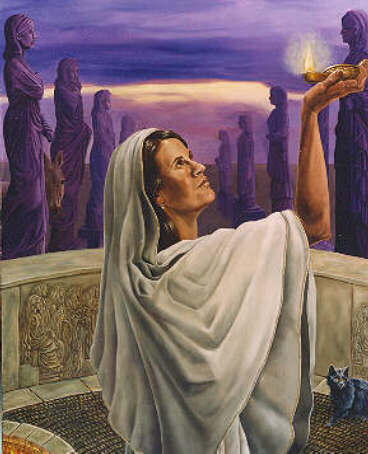 |
HilaeiraShe was a Goddess of Brightness, though that could also simply be a common epithet for goddesses.
HimaliaShe was a goddess invoked to bless the harvest. Thanks P J Criss.
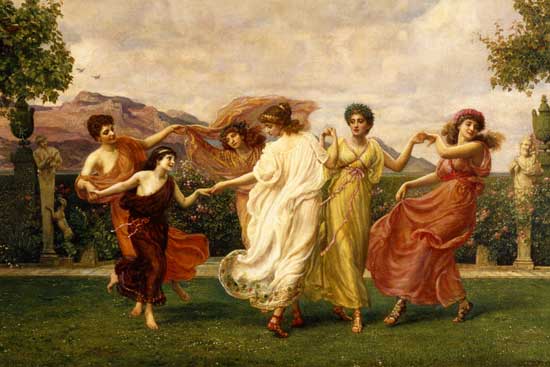 The HoraeThey were the goddesses orderly things like Seasons, and because of their orderly aspect eventually became goddesses of justice. They measured out the weather as it seemed appropriate and guarded Olympus from any overambitious mortals. They had a few cameos in the Big Myths: the Hora of Spring went with Persephone when she went down with Hades every year, and some of the Horae helped dress Aphrodite as she emerged from the ocean. They got different names (and numbers) from different authors, but I like Hesiod's breakdown:
The HoraeThey were the goddesses orderly things like Seasons, and because of their orderly aspect eventually became goddesses of justice. They measured out the weather as it seemed appropriate and guarded Olympus from any overambitious mortals. They had a few cameos in the Big Myths: the Hora of Spring went with Persephone when she went down with Hades every year, and some of the Horae helped dress Aphrodite as she emerged from the ocean. They got different names (and numbers) from different authors, but I like Hesiod's breakdown:- Eunomia, Good Custom
- Dike, Justice
- Eirene, Peace
Homer actually tended to keep them strictly with the seasons, and they only worshipped two in Athens, but Hyginus lists at least 21 Horae (including Horae of the Hours)! Generally they were happy little goddesses. Lots of cavorting, much like the Muses and the Graces (Charites) who they liked to hang out with when they weren't doing their day job of keeping track of orderly customs and justice.
HosiaHosia is a word placed before the names of Goddesses. It means something like "holy" and "praise" and other things along the same lines.

HygeiaShe was the daughter of Aesculapius, you know that dude who managed to raise people from the dead, and got struck down for it. She was the Goddess of Healing and she focuses on the healing power of cleanliness. She introduced the idea of washing patients with soap and water. She had lots of hospital shrines.
IambeI'm not sure that she counts as a goddess. She was the first priestess of Demeter, the daughter of Echo and Pan. She was the first to find the lamenting goddess after Persephone's rape and abduction, and she managed to cheer her up. Iambe was full of life and friendly nature.
IasoIaso was a Goddess of Healing and the daughter of Asclepius. He had lots of children. She was a sister of Hygia (see above).
IlythiaIlythia was the Goddess of Childbirth She is most known from the birth story of Artemis and Apollo, for it was she who went to Leto (see below) on the tiny island of Delos.
InvidiaA daughter of Pallas and Styx, Invidia was another personification of envy.

IrisIris is the Messenger Goddess.daughter of the Titan Thaumas and Electra. Although she was a sister of the winged monsters, the Harpies, Iris was represented as a beautiful maiden, with wings and robes of bright colors and a halo of light on her head, trailing across the sky with the rainbow she traveled on in her wake. She was also called the Goddess of the Rainbow.
KakiaKakia was a seductress. She was a Goddess of Vice, and she attempted to seduce Heracles with promises of wealth and ease. Obviously, he didn't give in.
The KeresThe Keres are also called the Dogs of Hades. They are associated with the Harpies and the Erinyes, and they are terrifying creatures. They are sharp clawed creatures who dress in red and drink the blood of their victims. They carry out the Fates' commands, insofar as they are in many ways the personification of the inevitability of death, and are often seen hovering around battle fields. They were daughters of Nyx, just like the Fates, and it can be a little unclear where their work ended and the work of the Erinnyes (see above) began.
KlotesA Goddess of Spinning.
KoliasA Goddess of Foothills.
KomodiaA Goddess of Happiness and Amusement. More like the personification of it.
KoreAn epithet of Persephone. Kore means the Maiden or Daughter.
KorosGoddess of Extravagant Joy.
KrateisHer name means "Mighty" and she was the mother of the monster Scylla by Phorcys.
KyprisAn epithet of Aphrodite, referring to her rising out of the sea from Cyprus. The whole Aphrodite cult CAME from Cyprus to Greece. She was HUGE there.
LacturaA Goddess of Corn.
LampetiaLampetia and her sister Phathusa were daughters of Helios. They were shepherdesses for him, and guarded his sacred cattle. Well, they did until Odysseus and his men came along and stole them. But then, they all died except Odysseus, so I'd say all's fair.
LetoFor someone in so many myths you'd think there'd be more about her! She was the daughter of the Titans Phoebe and Coeus, that makes her a sister of Asteria (the mother of Hecate - see above). She was the mother of the twins Artemis and Apollo. She was a Moon Goddess (not a big surprise, considering her parents and sibs. You definitely should read her story on the new stories page.
LeucotheaThe woman Ino married a married man, Athamas. She tried to make Athamas sacrifice his son Phrixes (it didn't happen, but that was how Helle, Phrixes' sister ended up dying). Anyway, Hera killed Ino, but Zeus made Ino into the Sea Goddess, Leucothea, or White Goddess, because she had raised Dionysus. There is another Leucothea too. But she was turned into an incense plant after her father buried her alive for being Helios' lover. Clytia, that nasty nymph, betrayed her.
LinaA Goddess of Weaving who used flax.
LipseA Goddess of the Wind. I'm not sure where that fits into Classical Mythology.
The LitaiThe Litai were the sisters of Ate. As you'll recall, Ate was evil. The goddess of temptation and all those yucky things. The Litai, who happened to be the personification of Prayers, followed Ate around and cleaned up after her. They tried to repair the damage she did to mortals.
LyssaA Goddess of the Underworld.
MaeraThere were actually two Maeras. The first was the daughter of Protus. This Maera was one of the cold Artemis' companions - her bad luck, in this case. For Zeus fell in love, and decided to pursue her. Artemis was NOT about that, and killed Maera (in that god-like logic, that I will never understand). Anyway, in the other version she is just a daughter of Atlas.

MaiaMaia was the oldest of the Pleiades, and she was chillin' in this cave in Arcadia when Zeus came and, skipping what happened in between, she bore Hermes (my favorite masculine God), and raised him in that cave, far away from Hera's jealous eyes. After Hermes' grows up, we don't hear much more about her. That picture on the left is one of Kris Waldherr's paintings.
MalophorusAn epithet of Persephone's as a Goddess of the Underworld. It means "sheep-bearer", probably a reference to the sheep that fell down with her when Hades opened the ground during his rape.
MeiboiaA Goddess of the Bee Cult.
MeilichiaA Goddess of the Underworld.
MelinoeA daughter of Zeus and Persephone. She was a Goddess of the Underworld, like her mother.
MelobosisA Goddess of Beneficence.
MetisMetis was another Titaness. She was the Goddess of Prudence, but there is a rather unprudent story about her that tells about the birth of Athena. Metis ends up living inside Zeus' head and giving him advice from there. Her name meant Wisdom and she was the personification of it as well as its Goddess. She was also the one who discovered (created) the potion that caused Cronos to vomit up the six OGs, (to all y'all who understand the joke, thank you for not being old).
MidaA Goddess of Oaths.
MnemosyneMnemosyne was a Titaness who was the Goddess of Memory. Her mother was Gaia and her father Uranus (the Sky). She was the mother of the Nine Muses (see below).
MolpadiaA Goddess of Childbirth.
The MusesThe Muses were nine daughters of Zeus and Mnemosyne. They played and sang all of the time and entertained the Gods and Goddesses on Mount Olympus. They also inspired creativity in everyone. The Muses were: - Erato, the Muse of Lyrics
- Euterpe, the Muse of Music
- Thalia, the Muse of Comedy
- Melpomene, the Muse of Tragedy
- Terpsichore, the Muse of Dance and Choral Song
- Urania, the Muse of Astronomy
- Clio, the Muse of Historical and Heroic Poetry, her name meant "Proclaimer"
- Polyhymnia, the Muse of Hymns
- Calliope, the Muse of Epics
The last Muse, Calliope, had a child with the King of Thrace. The child's name was Orpheus. There's a great story about him, so watch for the new story pages. There's also cool stories about each of the Muses, and some other Muses you probably didn't know about. For example, Did you know Clio introduced the Phoenician alphabet to Greece? Si, sono veritabile. Now the Muses have their own page! Check it out! In contains LOTS more information.
NeaeraNeaera means the New Moon. She was a couple of different people. One was a nymph mother of Lampetia and Phathusa by Helios. Another was the mother of Evadne. And another was the mother of Aegle by Zeus.
NemeaThis chica is the sister of Pandia, and the daughter of Selene and Zeus. She suckled the Nemean Lion (this scary monster type thing).
NemesisNemesis she was the right hand of Zeus. She was the Goddess of Righteous Anger and it was she who saw to it that all good and evil were justly paid. She was also without a direct personality. She is also called Adrasteia, which means the Inevitable Parents. She was either another daughter of Oceanus, or a daughter of Nyx and Erebus (making her a sister to Sleep and Death). I named my lacrosse stick after her.
|  |
NikeNike was similar to Eris because she was the constant companion to Athena. Nike was the Goddess of Victory. She was the daughter of the Titan Pallas and the River/Nymph Styx. She does not possess a distinct personality in any myths I've seen. Further, Nike was sort of an epithet of Athena. But Nike, as the personification of Victory was also worshipped as her own Goddess, and usually showed with wings, except in Athens where she was called "Apteros" ("wingless"), with the idea that she would never leave Athens.
|  |
 NyxNyx was a daughter of Chaos (and so a SISTER of Gaia, and with her brother Erebus (Darkness) she bore: Air, Hemera (see above), Aether (Light), Moros (Destiny), Thanatos (Death), Hypnos (Sleep), Morpheus (Dreams), The Fates, The Keres, Eris, Momus (Ridicule), Oizys (Distress), Apate (Deceit), Care, and Nemesis (see above). Her realm was in the far West beyond the land of Atlas.
NyxNyx was a daughter of Chaos (and so a SISTER of Gaia, and with her brother Erebus (Darkness) she bore: Air, Hemera (see above), Aether (Light), Moros (Destiny), Thanatos (Death), Hypnos (Sleep), Morpheus (Dreams), The Fates, The Keres, Eris, Momus (Ridicule), Oizys (Distress), Apate (Deceit), Care, and Nemesis (see above). Her realm was in the far West beyond the land of Atlas.
Next in Minor Goddesses: Odyne thru Volupta
Homepage |
The Famous Ones |
Goddesses |
Humans |
Nymphs |
Monstresses & Monstrosities |
The Myths Pages |
Amazons |
Men |
Terms |
Gallery |
Dreambook |
References & Links
Contact me at ailiathena@yahoo.com
Last Updated November 19, 2005
|



 The Horae
The Horae










